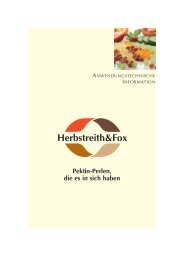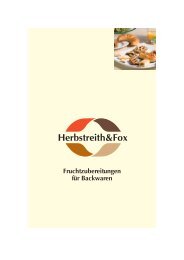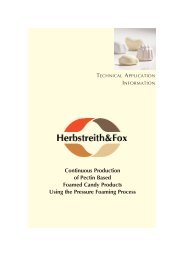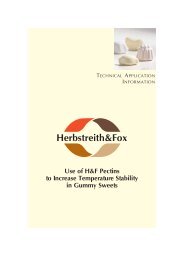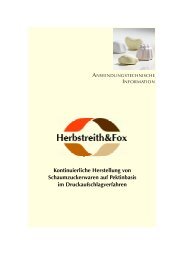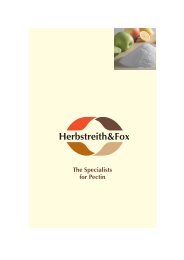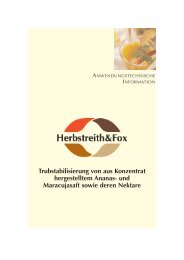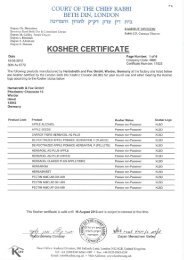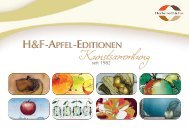Yoghurt Fruit Preparations - Herbstreith & Fox
Yoghurt Fruit Preparations - Herbstreith & Fox
Yoghurt Fruit Preparations - Herbstreith & Fox
You also want an ePaper? Increase the reach of your titles
YUMPU automatically turns print PDFs into web optimized ePapers that Google loves.
<strong>Fruit</strong> yoghurts have always been very popular<br />
among milk products. Today, as a consequence<br />
of the consumer’s desire for a healthy and<br />
fresh diet that is also low in calories, a wide<br />
range of fruit yoghurts can be found in food<br />
stores.<br />
In the manufacturing of fruit yoghurts, the<br />
fruit is usually added to the milk product in the<br />
form of fruit preparations.<br />
Here the addition of pectin as a thickening<br />
agent results in high-quality fruit preparations<br />
with exceedingly positive technological and<br />
sensory properties.<br />
<strong>Fruit</strong> yoghurts are mainly distinguished by the<br />
way the fruit preparation and the yoghurt are<br />
combined.<br />
The majority of yoghurts are stirred yoghurts<br />
where the fruit preparation is directly mixed<br />
with the stirred yoghurt and then filled into<br />
the containers.<br />
Another large group are layered products. In<br />
these products, the fruit preparation and the<br />
yoghurt are filled into the containers in succession.<br />
In the case of the fruit-bottom type, the<br />
fruit preparation is filled first and topped by<br />
the milk product, whereas in the fruit-at-thetop<br />
type the milk product is filled into the container<br />
first, followed by the fruit preparation.<br />
Another possibility is to separate the fruit preparation<br />
and the milk product by filling them<br />
into two-part containers. In the case of these<br />
two-part containers (fruit-corner products), the<br />
two components are mixed by the consumer or<br />
are consumed separately.<br />
Due to this variety, the features required of<br />
yoghurt fruit preparations mainly have to do<br />
with sensory properties, such as taste, appearance<br />
and texture. In addition to this, depending<br />
on the application, very specific technological<br />
properties are required, properties which<br />
in particular have to do with the rheological<br />
behaviour of the fruit preparation during processing<br />
as well as with the miscibility with the<br />
yoghurt and a possible reaction with calcium<br />
ions from the milk product.<br />
Besides their good processing properties (e.g.<br />
pumping properties), fruit preparations used in<br />
stirred yoghurts must for example display an<br />
excellent mixing behaviour with the milk<br />
product.<br />
In fruit preparations for layered products, not<br />
only are good pumping properties desirable,<br />
but also fast regeneration, in order to enable<br />
speedy layering. During storage, fruit preparations<br />
used in layered products must not react<br />
with calcium ions from the milk product, for<br />
this could cause a change of texture.<br />
In the case of fruit preparations for yoghurts in<br />
two-part containers, sensory requirements as<br />
to appearance and texture are especially high,<br />
since consumers expect not only a good mixing<br />
behaviour, but also an appealing and appetising<br />
appearance of the fruit preparation.<br />
For use in yoghurt fruit preparations, H&F offers<br />
Classic Apple Pectins and Low Methylester<br />
Amidated (”Amid”) Pectins, standardised<br />
specially for these applications. This way, optimum<br />
sensory and technological properties can<br />
be achieved in each product.<br />
5<br />
Pectins in <strong>Yoghurt</strong> <strong>Fruit</strong> <strong>Preparations</strong>



